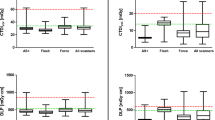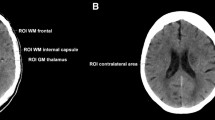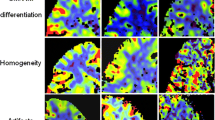Abstract
Introduction
The objective of this study was to determine the radiation dose delivered during comprehensive computed tomography (CT) imaging for acute stroke.
Methods
All CT examinations performed over 18 months using our acute stroke protocol were included. Protocol includes an unenhanced CT head, CT angiography from the arch to vertex, CT perfusion/permeability, and an enhanced CT head. All imaging was acquired with a 64-MDCT. Examinations where any element of the protocol was repeated or omitted due to mistimed injection or patient motion were excluded. Dose-length products (DLP) for all components of each examination were obtained from dose reports generated at the time of acquisition, separating neck, and head calculations. Effective doses for each examination were calculated using the DLP and normalized values of effective dose per DLP appropriate for the body regions imaged.
Results
Ninety-five examinations were included. Mean DLP was 6,790.0 mGy·cm. Effective doses ranged from 11.8 to 27.3 mSv, mean effective dose of 16.4 mSv. Mean effective dose for acquisition of the unenhanced head was 2.7 mSv. Largest contribution to effective dose was the CTA with a mean effective dose of 5.4 mSv. Mean effective dose for the CT perfusion was 4.9 mSv.
Conclusion
A comprehensive CT acute stroke protocol delivered a mean effective dose of 16.4 mSv, which is approximately six times the dose of an unenhanced CT head. These high-dose results must be balanced with the benefits of the detailed anatomic and physiologic data obtained. Centers should implement aggressive dose reduction strategies and freely use MR as a substitute.


Similar content being viewed by others
References
O’Rourke F, Dean N, Akhtar N, Shuaib A (2004) Current and future concepts in stroke prevention. CMAJ 170:1123–1133
Statistics Canada (1997) Selected leading causes of death by sex. Statistics Canada, Ottawa
The National Institute of Neurological Disorders and Stroke rt-PA Stroke Study Group (1995) Tissue plasminogen activator for acute ischemic stroke. N Engl J Med 333:1581–1587
del Zoppo GJ, Higashida RT, Furlan AJ et al (1998) PROACT: a phase II randomized trial of recombinant pro-urokinase by direct arterial delivery in acute middle cerebral artery stroke. Stroke 29:4–11
Furlan A, Higashida R, Wechsler L et al (1999) Intra-arterial prourokinase for acute ischemic stroke. The PROACT II study: a randomized controlled trial. Prolyse in acute cerebral thromboembolism. JAMA 282:2003–2011
Mullins ME, Schaefer PW, Sorensen AG et al (2002) CT and conventional and diffusion-weighted MR imaging in acute stroke: study in 691 patients at presentation to the emergency department. Radiology 224:353–360
Lovblad KO, Laubach HJ, Baird AE et al (1998) Clinical experience with diffusion-weighted MR in patients with acute stroke. Am J Neuroradiol 19:1061–1066
Baird AE, Lovblad KO, Dashe JF et al (2000) Clinical correlations of diffusion and perfusion lesion volumes in acute ischemic stroke. Cerebrovasc Dis 10:441–448
Singer OC, Sitzer M, du Mesnil de Rochemont R, Neumann-Haefelinl T (2004) Practical limitations of acute stroke MRI due to patient-related problems. Neurology 62:1848–1849
Wintermark M, Meuli R, Browaeys P et al (2007) Comparison of CT perfusion and angiography and MRI in selecting stroke patients for acute treatment. Neurology 68:694–697
Miles KA (2004) Brain Perfusion: computed tomography applications. Neuroradiology 46(Suppl 2):S194–S200
Aviv RI, d’Esterre C, Murphy B et al (2009) Relationship between CT perfusion derived blood-brain barrier permeability surface area product and hemorrhagic transformation of ischemic stroke. Radiology 250:867–877
Huda W, Ogden KM, Khorasani MR (2008) Converting dose-length product to effective dose at CT. Radiology 248:995–1003
Jessen KA, Shrimpton PC, Geleijns J et al (1999) Dosimetry for optimization of patient protection in computed tomography. Appl Radiat Isot 50:165–172
Katz SI, Saluja S, Brink JA, Forman HP (2006) Radiation dose associated with unenhanced CT for suspected renal colic: impact of repetitive studies. Am J Roentgenol 186:1120–1124
Horiguchi J, Kiguchi M, Fujioka C et al (2008) Radiation dose, image quality, stenosis measurement, and CT densitometry using ECG-triggered coronary 64-MDCT angiography: a phantom study. Am J Roentgenol 190:315–320
Cohnen M, Wittsack HJ, Assadi S et al (2006) Radiation exposure of patients in comprehensive computed tomography of the head in acute stroke. Am J Neuroradiol 27:1741–1745
Imanishi Y, Fukui A, Niimi H et al (2005) Radiation-induced temporary hair loss as a radiation damage only occurring in patients who had combination of MDCT and DSA. Eur Radiol 15:41–46
Pierce DA, Preston DL (2000) Radiation-related cancer risks at low doses among atomic bomb survivors. Radiat Res 154:178–186
Cardis E, Vrijheid M, Blettner M et al (2007) The 15-country collaborative study of cancer risk among radiation workers in the nuclear industry: estimates of radiation-related cancer risks. Radiat Res 167:396–416
National Council on Radiation Protection and Measurements (1993) Limitation of exposure to ionizing radiation. NUCRP report 116. National Council on Radiation Protection and Measurements, Bethesda
Committee to Assess Health Risks from Exposure to Low Levels of Ionizing Radiation, National Research Council (2006) Health risks from exposure to low levels of ionizing radiation: BEIR VII phase 2. National Academies, Washington, DC
Shrimpton PC, Hillier MC, Lewis MA et al (2006) National survey of doses from CT in the UK: 2003. Br J Radiol 79:968–980
Hall EJ, Giaccia AJ (2006) Radiation cataractogenisis. In Radiobiology for the radiologist, 6th edn. Lippincott Williams Williams, Philadelphia
Neriishi K, Nakashima E, Minamoto A et al (2007) Postoperative cataract cases among atomic bomb survivors: radiation dose response and threshold. Radiation Research 168:404–408
Wintermark M, Maeder P, Verdun FR et al (2000) Using 80 kVp versus 120 kVp in perfusion CT measurement of regional cerebral blood flow. Am J Neuroradiol 21:1881–1884
Hirata M, Murase K, Sugawara Y et al (2005) A method for reducing radiation dose in cerebral CT perfusion study with variable scan schedule. Radiat Med 23:162–169
Smith AB, Dillon WP, Lau BC et al (2008) Radiation dose reduction strategy for CT protocols: successful implementation in neuroradiology section. Radiology 247:499–506
Ederies A, Demchuk A, Chia T et al (2009) Postcontrast CT extravasation is associated with hematoma expansion in CTA spot negative patients. Stroke 40(5):1672–1676
Smith AB, Dillon WP, Gould R et al (2007) Radiation dose-reduction strategies for Neuroradiology CT protocols. Am J Neuroradiol 28:1628–1632
Author information
Authors and Affiliations
Corresponding author
Rights and permissions
About this article
Cite this article
Mnyusiwalla, A., Aviv, R.I. & Symons, S.P. Radiation dose from multidetector row CT imaging for acute stroke. Neuroradiology 51, 635–640 (2009). https://doi.org/10.1007/s00234-009-0543-6
Received:
Accepted:
Published:
Issue Date:
DOI: https://doi.org/10.1007/s00234-009-0543-6




